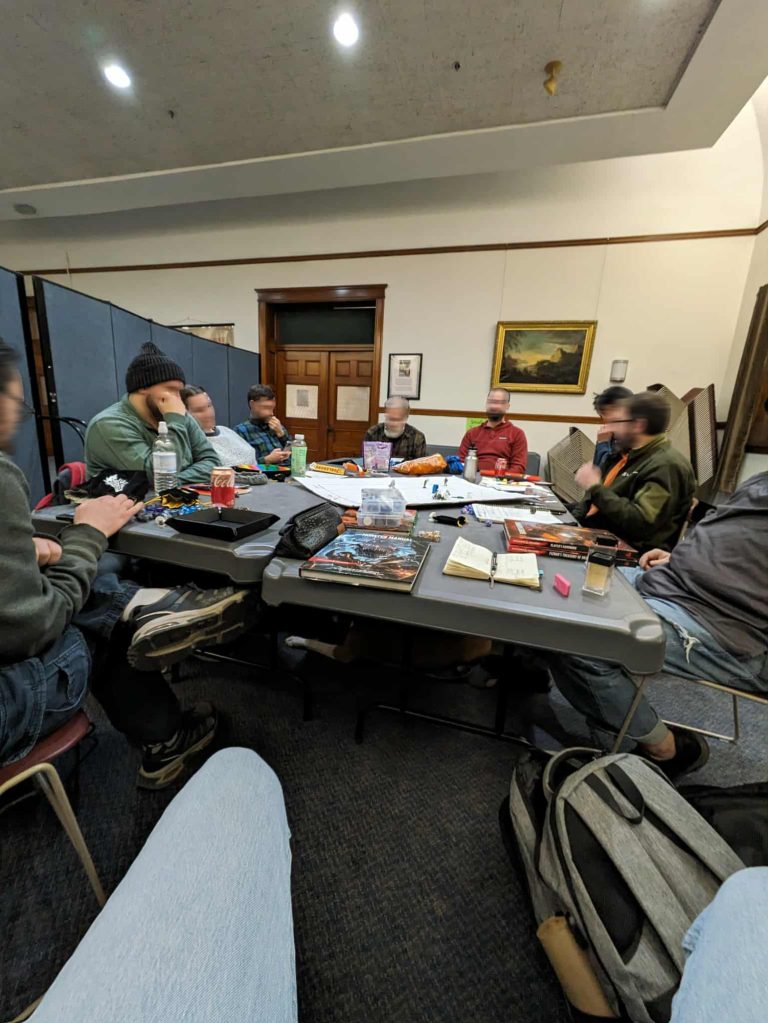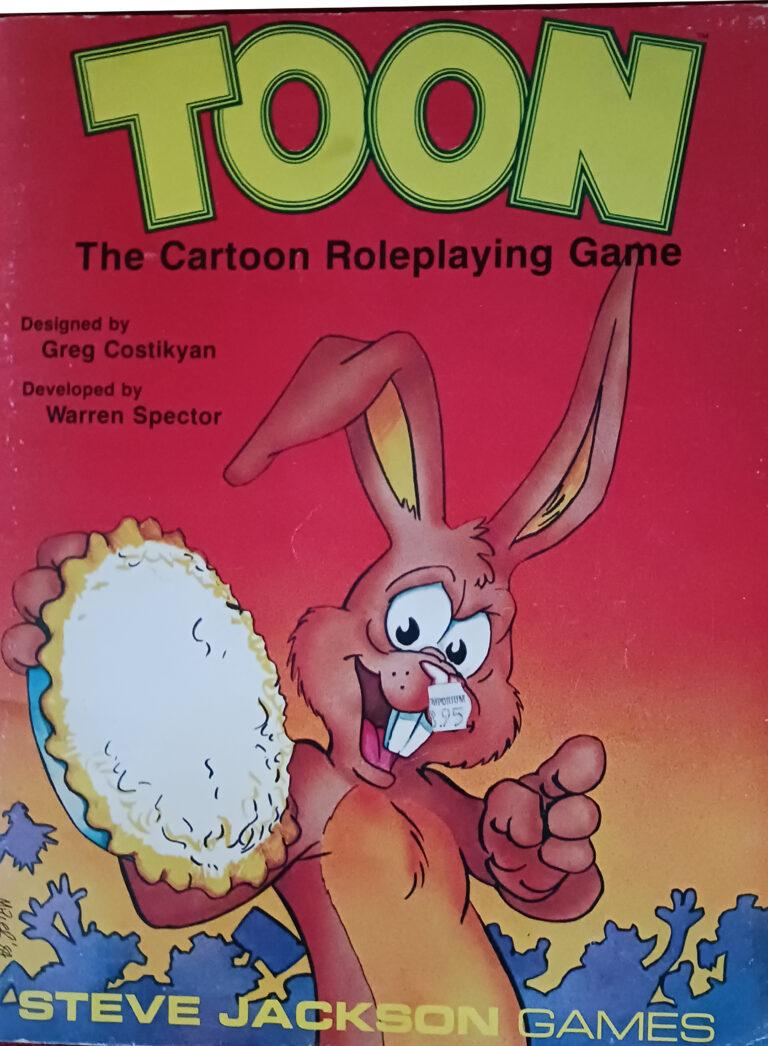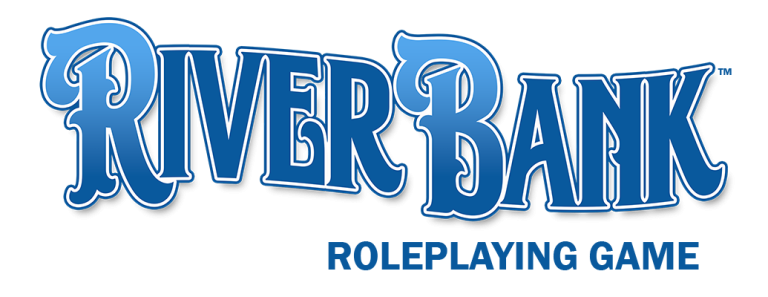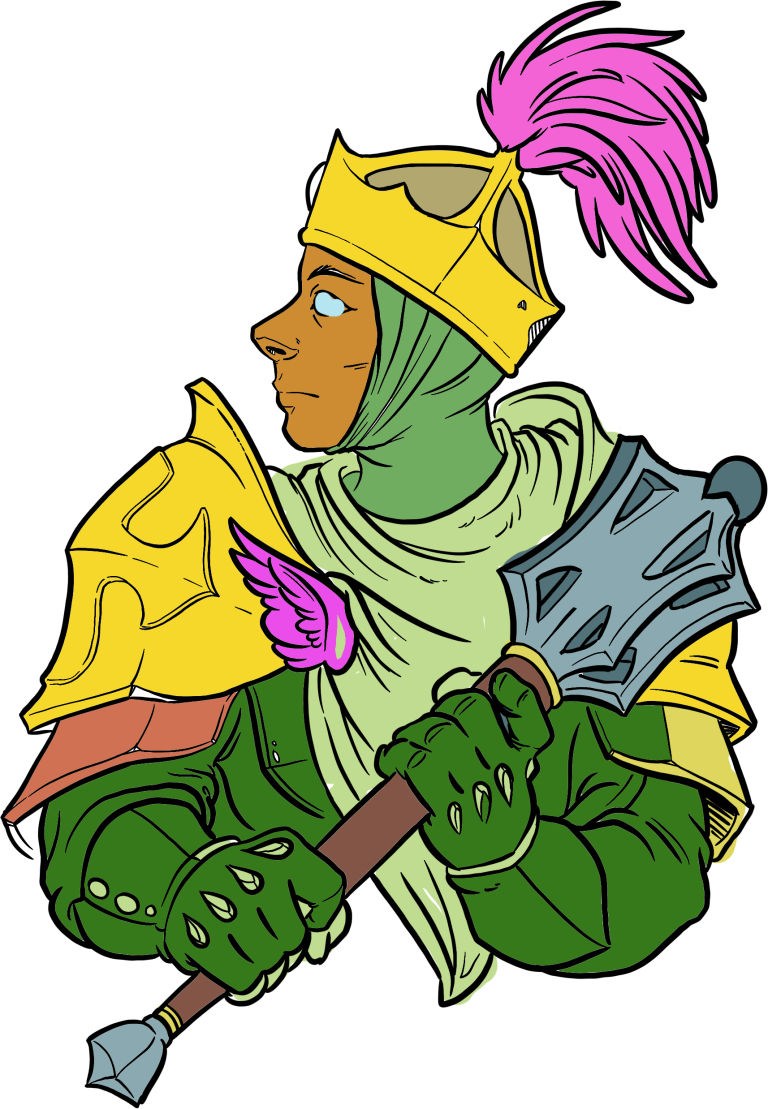Today (and stay tuned next week…) we have an interview with Claire Stricklin, a member of the staff from Adventure A Week. Adventure A Week has released new tabletop roleplaying game adventures to subscribers every week since 2012. They’ve collected many of these adventures in crowd funded printed volumes, Let’s hear from Claire!
How did you get started playing TTRPGs? What was the first TTRPG you’ve played?
You guys ever play DragonStrike? It was Hero Quest’s less famous little brother, and these days it’s probably most famous for the VHS tape that came in the box. (Seriously, you should watch this ridiculousness. It still cracks me up.) This was the game that got me into the hobby in the first place. I still remember badgering my poor beleaguered mom into playing the part of the Dragon Master (DM), and even more clearly I remember getting my butt kicked by the game.
I lost my copy of DragonStrike somewhere in the depths of time…probably when we moved to North Carolina in the summer between 3rd and 4th grade. I had always pined for a replacement, and a few years back a friend actually tracked one down for X-mas. I tore into the paper, beheld the glorious box art, and felt an extremely nerdy nostalgia-tear forming in my eye. There were the boards! The character cards! The fondly remembered plastic minis! We set up, sat down, and I got ready to get my butt kicked. After a quick refresher of the rules (huh…turns out there was a “talk to the monster” option in there. Weird.) it was off to the castle.
First round of the first encounter. There was a drawbridge with a gargoyle standing guard.
“Hi!” says the thief player. “Would you mind letting us past?”
“Sure,” says the gargoyle, who promptly winged away.
Meanwhile I’m sitting there with my warrior (wait a minute… Malibu!?) with my mouth agape. Did that just happen?
My pal the DM read the instructions aloud and assured me that yeah, that’s exactly what happens. Too bad 3rd grader Claire never figured that out. It would have made my mom a much less conceited DM.
We plowed through the rest of the adventure with nary a problem, and even managed to beat up the “very difficult” scenario in the next round. I’m sure that my current gaming group has better tactics than my long-ago little kid pals, but I honestly think that whole “try talking to the monster” trick was the real key to our success. Not a bad lesson for game designers, now that I think about it.
What’s a TTRPG you’d recommend?
I’m a dungeon delver at heart, and have a particular soft spot for d20s and high fantasy.
That said, my other favorite game is Exalted 2e. The stunt system in that game is all manner of interesting. It’s similar to 5e’s inspiration, but slightly more central to play. Exalted features a dice pool system, so the more dice you roll the better your results tend to be. Here’s a quick copy/paste of the stunting rules by way of explanation:
The rules of Exalted reward players with additional dice for describing their characters’ actions in an evocative manner. The out-of-game rationale for a stunt bonus is that well-described actions keep the game interesting for everyone and help the Storyteller set the scene. In game, stunts represent the capacity of epic heroes to be truly spectacular when they take risks and act like heroes. At the lowest level, one-die stunts require a good description of an action, adjudicated by the Storyteller. In return, the player gains one additional die, and the character may perform feats that border on impossible (such as running across the heads of people in a crowd, deflecting a blade or arrow barehanded and so on).
That’s just the basics though. If you get more elaborate you may get more dice. And let me tell you, there’s nothing quite as pump-a-fist awesome as earning that big three dice stunt for truly epic plays.
You developed the city of Hordenheim and the continent of Trectoyri? What was the inspiration for those?
I owe a lot to those projects. They gave me a sense of my own identity within the industry.
Trectoyri was part of a project called The Veranthea Codex. You can get a taste with a free NPC download over here, but the place can be best summed up as “Goblins. In. Zeppelins!” The whole continent of Trectoyri was an answer to the question, “What if the monsters won?” My answer involved industrialization. With goblin inventors set loose to pillage a continent’s worth of natural resources, you quickly wind up with metropolitan monster megalopolises, ogre biker gangs, and sky pirates dogfighting with dragons. It was my first real crack at an outrageous genre, and it felt liberating to play in a world of dieselpunk rather than high fantasy.
Of course, The Veranthea Codex was somebody else’s baby. It was a setting that came out of the publisher’s home game. I was proud to be a part of the team, playing in the same sandbox as people like Larry Dixon and Paizo’s Luis Loza. But even if I loved my little corner of that world, it wasn’t really mine.
That’s where Hordenheim comes in. I’m a big Terry Pratchett fan, with a particular love for the Ankh-Morpork City Watch. Pratchett’s idea of a fantasy metropolis facing contemporary problems (e.g. ethnic tensions, corrupt officials, biased policing, etc.) was a great springboard for my own take on the trope. I wound up inventing a necromancy-based sheriff’s office, an evil real estate developer, and an urban university across three modules. Hordenheim was my first major project under AAW Games. It was also my first chance to develop something from the ground up. As a young writer eager to prove myself, it was a perfect opportunity.
I mentioned finding ‘my identity within the industry.’ Across those two projects, I discovered my footing in unconventional settings and comic fantasy. That’s become something of a brand for me, and I still love the combination to pieces.
How did you get started writing the webcomic Handbook of Heroes? What is your favorite part of writing for comics?
Well hey, I was just talking about comedy, right? My webcomic The Handbook of Heroes (that’s handbookofheroes.com, check our Patreon), is a collaboration with illustrator Laurel Shelley-Reuss. She’s a White Wolf alum and a graduate of the SCAD sequential art program. We’d been gaming together for years by the time she said, “You never shut up about gaming. Why don’t you write a blog or something?”
I don’t know if she realized I’d drag her along with me.
As a writer, the best part of comics is the collaboration. There are sight gags that come from her brain, not mine. The character designs (and occasional redesigns) are always a blast to see for the first time. But more than the visual treats, it’s wonderful to have a flanking partner to bounce ideas around. As you might guess, I love me some gaming shop talk. Handbook gives me a frequent excuse to indulge.
How did you decide to write your dissertation on TTRPG podcasts?
After seven years as a state employee, I realized I missed academia. I was an English major at heart, and I loved nothing better than talking about ideas and narrative. When I went back for my MA at the University of Wyoming, there was an Aurthurian Lit class that let me write my final paper on the board game Shadows Over Camelot. I had great fun talking about the traitorous Mordred, the despair of the Grail Quest, and the ways the game mechanics reflected these ideas.
That’s when I realized, Oh my God! I can use all of these analytical English major skills for game design as well as literature!
By the time one of my profs introduced me to Henry Jenkins’s Convergence Culture, I had found an academic discipline that could tie my interest in gaming to contemporary media studies. With Critical Role blowing up at the time, it wasn’t hard to see where some opportunities for new scholarship would emerge.
I wound up writing that MA thesis on collaborative narrative, using The Glass Cannon Podcast as my case study. By the time I got to Georgia Tech and my Digital Media PhD, I had translated that interest into a user study of actual players and their audiences. I wanted to create tools to help actual players engage their audiences on streaming platforms. The talking mechanical raven that resulted was inspired by a certain wondrous item, and was an absolute blast to playtest.
What advice do you have for aspiring podcasters?
The key difference between a home game and an actual play is your audience. They will write in to ask questions, jump into chat, offer their own suggestions, and bring unique perspectives to the table. In that sense, your viewers aren’t just an audience. They’re an active audience. Figuring out how to get them involved is your priority.
How do they affect the story? How can they affect the story? If someone can crack that code, I think they’re going to have a hit on their hands.
In more concrete terms, I’m talking about elements like “make your own NPC” backer rewards on Patreon, improv style “give me a suggestion for the next monster” in live chat, and integrating Twitch Polls into your game. All of these can give an active audience buy-in to the show. The opportunity is making your audience as collaborators rather than passive viewers.
After all, that’s what we do as gamers for one another. Designers know that dungeon masters will pick apart our modules and repurpose them for their own ends. GMs (the good ones) let players do the same with their game worlds. Why not extend the same courtesy to audiences?
What’s your favorite poem? What’s your favorite poem that you wrote?
Ha! It’s been a fair few years, but I was asked to memorize a poem and recite it as a kid. I chose one from my first ever bestiary. This wasn’t a proper gaming bestiary, but a dictionary of magical beasts I’d inherited from my father. It included a ballad called “The Double-Headed Snake of Newbury,” by John Greenleaf Whittier. You can find it easily enough online, but I no longer have to. I’ve still got that sucker memorized.
The Double-headed Snake Of Newbury
Far away in the twilight time
Of every people, in every clime,
Dragons and griffins and monsters dire,
Born of water, and air, and fire,
Or nursed, like the Python, in the mud
And ooze of the old Deucalion flood,
Crawl and wriggle and foam with rage,
Through dusk tradition and ballad age.
So from the childhood of Newbury town
And its time of fable the tale comes down
Of a terror which haunted bush and brake,
The Amphisbaena, the Double Snake!
Whether he lurked in the Oldtown fen
Or the gray earth-flax of the Devil’s Den,
Or swam in the wooded Artichoke,
Or coiled by the Northman’s Written Rock,
Nothing on record is left to show;
Only the fact that be lived, we know,
And left the cast of a double head
In the scaly mask which he yearly shed.
For he carried a head where his tail should be,
And the two, of course, could never agree,
But wriggled about with main and might,
Now to the left and now to the right;
Pulling and twisting this way and that,
Neither knew what the other was at.
A snake with two beads, lurking so near!
Judge of the wonder, guess at the fear!
Think what ancient gossips might say,
Shaking their heads in their dreary way,
Between the meetings on Sabbath-day!
How urchins, searching at day’s decline
The Common Pasture for sheep or kine,
The terrible double-ganger heard
In leafy rustle or whir of bird!
Far and wide the tale was told,
Like a snowball growing while it rolled.
The nurse hushed with it the baby’s cry;
And it served, in the worthy minister’s eye,
To paint the primitive serpent by.
Cotton Mather came galloping down
All the way to Newbury town,
With his eyes agog and his ears set wide,
And his marvellous inkhorn at his side;
Stirring the while in the shallow pool
Of his brains for the lore he learned at school,
To garnish the story, with here a streak
Of Latin, and there another of Greek
And the tales he heard and the notes he took,
Behold! are they not in his Wonder-Book?
Stories, like dragons, are hard to kill.
If the snake does not, the tale runs still
In Byfield Meadows, on Pipestave Hill.
And still, whenever husband and wife
Publish the shame of their daily strife,
And, with mad cross-purpose, tug and strain
At either end of the marriage-chain,
The gossips say, with a knowing shake
Of their gray heads, ‘Look at the Double Snake
One in body and two in will,
The Amphisbaena is living still!’
That love of language, rhyme, and the music of the spoken word led me to entering a poetry contest in high school. I wrote a piece called “For the Poets.” It was all about the lineage of inspiration that we as writers owe to our predecessors. I somehow managed to win the contest, and it was the first time I had been paid for writing anything.
Nothing but a press release remains online, so you can’t find it anywhere. I suspect my younger self would be honored to share it here.
For The Poets
I write because I
Owe something to dead poets,
To young poets
And old alike,
To muses who pick up a pen
And give ink-flesh to truth,
Beauty, history, life
What have you,
To the purveyors of lost causes
And busted dreams
That put lifeblood’s work on a page,
All the all-lovers
And anarchist antiestablishment roarers
That ever soul-fed a ragged notebook.
I write for the jaded man-haters,
The naïve idealist infants,
The bohemian bebop beatniks
That spoke in smoke-hushed cafes,
For the middle-aged dying
That still have something left to shout at heaven,
For the young man disillusioned
That had something to say,
For the fast-living deep-breathers
That exhaled a sensation to life.
I write to hear new echoes
Of a blind minstrel’s ballad,
To honor the unappreciated dead,
Posthumous laughing at their fame,
To rewind and play back lost hero sagas
That still pertain to us,
To sing in new voice a chorus of reverberations.
I write for the mirror-facing-mirror inspiration
My predecessors left with cave-wall stylus,
Ink-scrawl quill,
Cedar on graphite gray
And dime-operated keyboard.
I write for wordsmiths past
And the unborn stanza-operators
That come when I recede into half-forgotten quotations.
I write because I owe something to the poets.
I write because I’m a poet too.
What’s your favorite part of working for AAW Games?
The people. I mentioned my love of collaboration before, and it’s the same here. Having a group of creative game designers celebrating your work, helping you through the writer’s block and tricky mechanics questions, and brainstorming their own additions is a far cry from the lonely labor of the solo author burning the midnight oil at her keyboard. I’m a natural extrovert, so working along with my friends and colleagues is an ideal setup for me.
That goes double for our fans. There has never been a more engaged and active group of geeks in all the great wide web. Listening to their feedback, answering their questions, and bouncing ideas around on the AAW Discord and Kickstarter comments sections is one of my favorite parts of the job. It’s not so long ago that I was “just a homebrew GM” myself. These people are gamers, just like me. And as we’ve already established, I do love me some shop talk.
What else would you like us to know that we haven’t asked you yet?
I probably ought to say a word or two about identity in gaming. I only figured out I was trans a year ago. I’m still getting used to the face in the mirror. But as I look back on my journey, It’s funny to track my progress through The Handbook of Heroes. I went from, “I’m nervous about playing a female PC,” to, “I’m glad I played a female PC,” to, “Um, guys? I should probably let you know why I’m changing my author avatar.”
My experience is far from universal. Trying out “crossplaying” doesn’t mean you’re trans anymore than singing outside your gender at karaoke night. But for me (and I suspect for other people like me) RPGs offered a safe place to test drive my identity.
Identity formation is a popular topic in my academic circles, but even outside of scholarly pursuits, making room at the table is good policy. The three-sexed Shirren in Starfinder, the androgynous elven deity Corellon Larethian, and even the bearded ladies of Middle Earth all serve to make their worlds richer and more complex. Even more than the world-building opportunities though, helping players to feel welcome inside your world is the mark of a good GM.
The phrase “representation matters” makes for handy shorthand, but I find that it undersells the concept. What we’re actually talking about is the ur-fantasy that undergirds gaming. We’re talking about the power fantasy. Think of dust jacket blurbs and back-of-the-box exclamation points: You can become the hero of your own adventure!!! Making sure that others can see themselves holding aloft the Sword of Power or wielding the Word of Blasting is essential to the experience.
We all make stories together, player to player and author to audience. Our hobby is fundamentally a co-creative one. And I believe that learning to listen to those other voices — especially when they’re very different from our own — is at the heart of co-creation.
Thanks, Claire! come back Next Wednesday, June 21st for our interview with AAW Lead Designer Thilo Graf







